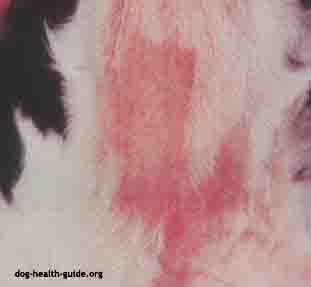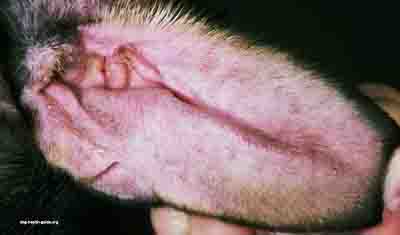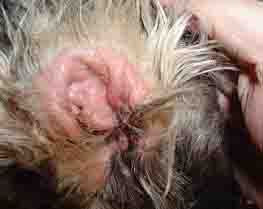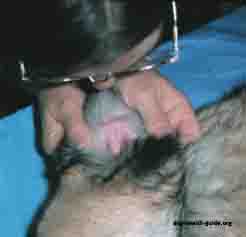Summary:
"Is your pet suffering from a dog yeast infection (malassezia dermatitis)? If you see scratching on the ears (otitis), cracking of the lips (chelitis), inflamed skin (dermatitis) or chewing of the paws then odds are this is problem. One particular type of yeast, Malassezia naturally lives on dog skin, but can cause a problem when over population occurs due to damp skin or ears, or as a reaction to certain medications. In normal quantities malassevia helps the body prevent of slow the growth of bacteria or fungi. Symptoms include itch and a smell that is similar to a smelly cheese. Treatment involves the use of prescription topicals or home remedy."

Overview
Yeast naturally lives on dog (and human) skin and in the ear canal. Under the right conditions the yeast will grow into quantities that irritate dog skin or ears. For example, dogs with skin folds have the damp conditions in which yeasts like to grow. Dogs that have allergies that seem to worsen or that exhibits resistance to steroid treatment are also considered to be more susceptible to the condition.
Many dogs also have a bacterial skin infection (bacterial folliculitis) and endocrine problems at the same time.
Causes
The reasons for yeast overpopulation or for the yeast to turn into a pathogen are not well understood. There are several causes that will be considered by a veterinarian:
- Medications
- Steroids when prescribed for allergies make it harder for the skin to keep the yeast from multiplying
- Antibiotics kill bacteria that can help prevent yeast infection
- Foreign object in ear
- Trapped water in a dog ear
- Ear Growth
- Seborrheic conditions (especially in younger dogs)
- Genetics
- Hormonal factors (endocrine disorders, particularly in older dogs)
- Atopic Dermatitis
- High humidity and temperatures
- Hypersensitivity to allergens (might be a predisposing factor)
Areas of the Body Most Effected
- Lips
- Ears
- Feet/paws
- Where the leg meets the body (axillae)
- Groin (inguinal)
- Ventral neck (part closest to the abdomen)

Breeds and Dog Malassezia
The following dog breeds have a higher incidence of dog yeast infection:
- Flat-nosed breeds
- Bulldogs
- Pugs
- Dos with floppy ears
- Basset Hounds
- Cocker Spaniel
- West Highland white terrier
- Poodle
- Dachshund (needs to be differentiated from Acanthosis nigricans, a condition with dark wart like patches in the body folds)
Symptoms
As mentioned, yeast acts as an allergen which irritates the skin. Skin symptoms include:
- General dog yeast infection symptoms
- behavioral change
- head tilting
- walking in circles
- scooting on rear across floor, carpet or gras
- On dog ear
- scabs around the ear due to scratching
- black waxy substance and smell

Diseases with Similar Symptoms
There are several diseases or problems with similar symptoms that will need to be ruled out prior to reaching a diagnosis:
- Flea allergy
- Atopy (seasonal inhaled allergens)
- Superficial bacterial folliculitis
- Seborrhea
- Acanthosis nigricans (dachshunds only)

Diagnosis of Malassevia Dermatitis and Otic Overgrowth
A veterinarian can diagnosis a dog yeast infection during a clinical examination. The vet will check the ears using a device called an otoscope. They can also inspect any fluid under a microscope. Tests are designed to determine if there is an excessive amount of yeast on diseased skin or ears using a fungal culture reviewed under a microscope.
Treatment
In most cases the veterinarian will prescribe a topical ointment or cream that contains an anti-fungal such as Ketoconazole or miconazole. Dog yeast infection treatment can last from 30 days in most cases to months for more chronic conditions. A shampoo containing miconazole or chlorhexidine such as Malaseb is considered to be most effective.
After therapy begins, the veterinarian will want to see the patient in 2 to 4 weeks to monitor progress. Symptoms such as itch and any odor should stop by the end of the first week. Regular bathing should decrease the frequency of recurrence (also see natural remedies below).
Note that keoconazole should not be used in dogs that have liver disease. Oral medications are also available via prescription that can be used along with topical treatments (Itraconzole, Fluconazole, Terbinafine-LamisilR).
Home Remedies
- Vinegar and Water: The use of vinegar and water in the ration of (25:75 percent) will work in some cases for treating a dog ear yeast infection. If you try this approach, see a veterinarian if you don't see improvement.
- Natural Remedies: A natural remedy such as Ear Dr., which contains a mix of natural and herbal ingredients could provide some short term relief of ear related symptoms and strengthen the body's natural yeast defense. Worth a try if your dog is predisposed to ear infections. Owners often prefer this approach for treating ear infections in dogs since it avoids the side effects of antibiotics.
Dog Yeast Infection Diet
If your dog has food allergies, then they may be more susceptible to a dog yeast skin infection. As your veterinarian for a diet that does not encourage yeast growth, yet provides the proper levels of nutrition.
Prevention
The key to prevention is to prevent the conditions that allow yeast on dog skin or in the ears to multiply. This includes keeping the ears and dog paws dry. For the ears, have a groomer trim the hair around the ears.
Have A Question or Story About Dog Ringworm or Other Canine Fungal Infections?
Do you have a Dog Ringworm or Canine Fungus related Question for our Editors or a Helpful Story to Share? Please include information such as age, sex, breed, medical history, skin and other symptoms, medications your dog is taking, recent changes in behavior, etc. A picture of the condition would also be helpful.
We will do our best to get back to you quickly (depends on how many questions we receive each day). If you do require an immediate response we suggest using this online dog veterinary service that is available now.
More Information on Dog Malessevia Dermatitis
References
- Washington State University
- Can Veterinary Journal, Volume 38, May, National Center for Biotechnology
Dog Watch
Cornell University College of Veterinary Medicine
Malassezia Dermatitis and Malassezia Otic Overgrowth
Daniel O. Morris, DVM, MPH, Diplomate, ACVD
School of Veterinary Medicine
University of Pennsylvania, Philadelphia, PA
Researched by: Jeff Grill
